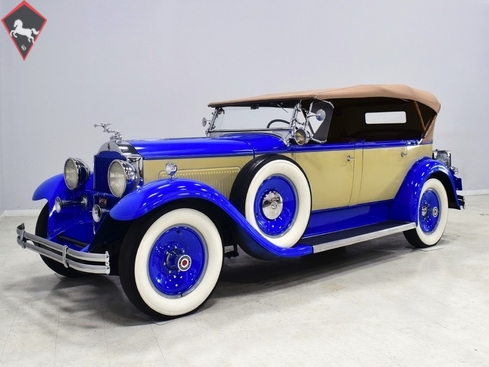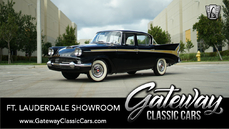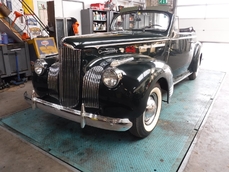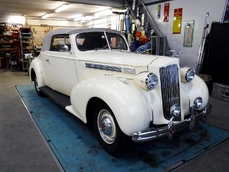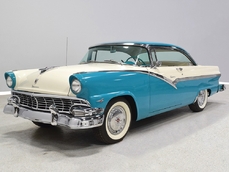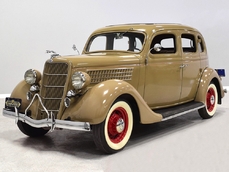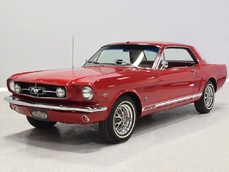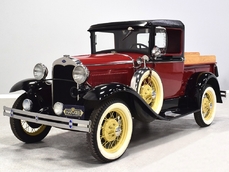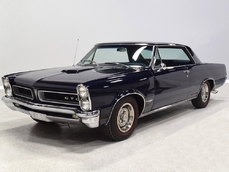Packard Other 320 cubic inch straight-8 1931
Allmän beskrivning :
Do we really need to tell you how wonderful Packards are? They are easily the most popular luxury marque of the 1930s, and the combination of gorgeous styling, rugged mechanicals, and easy road manners make them perennial favorites. For touring, few early cars can match a Packard’s pace and those equipped with more sporting bodies—roadsters and touring cars—remain some of the most highly-sought vehicles of the era. Packard largely disregarded model years, instead revising their cars by Series, with their model designations indicating the Series and wheelbase. For instance, this lovely 5-passenger phaeton is an 8th Series Packard on a 133-inch wheelbase chassis (which was actually 134.5 inches, but who’s counting?), hence the 833 nomenclature. For convention’s sake, they are usually referred to as 1931 model year vehicles, but this one is titled as a 1930, ostensibly because it was sold in late 1930. Regardless of the numbers, it’s a big, powerful, handsome, desirable car.
This Packard 833 phaeton was first restored in the 1970s and wore the familiar color combination that was popular at the time: brown, orange, and tan. Workmanship was excellent and for the most part, it was holding up beautifully, but it was starting to look a little dated. Four years ago, the body was partially disassembled and the brown and orange areas were repainted a bright Packard blue, updating the look without requiring a complete tear-down. The reason for that, of course, is because this is a favorite tour car and taking it off the road would have been problematic—it’s just too good at driving. The result is a handsome and very flashy phaeton that demonstrates why Packards are so popular, year after year. You’ll note that the bodywork is quite good, with no signs of rust or botched repairs in the past, and it’s likely that this car has always been clean, straight, and well-maintained. The doors fit well and close with a light “whap!” because, of course, they’re framed in wood and don’t weigh much at all. The new blue paint has a great shine and thanks to a simple tan pinstripe that matches the body’s primary color, it has a period-correct appearance without looking over-done.
Most of the chrome probably dates to the 1970s restoration, but it’s excellent throughout with very few signs of age. Experts will note that the horns are not correct for an 8th Series but they look right (and the original horn bracket is still under the hood), and it has been fitted with an accessory spotlight and an authentic Packard trunk on the rack out back. A second taillight assembly has been added on the passenger side for safety (the car has turn signals) and the running boards have been recently renewed so they look fantastic. Two hood ornaments are included, too: the currently installed and optional “donut pusher” goddess of speed, and the plain cap that was standard equipment. If a traditional Full Classic Packard phaeton is on your wish list, this car nails the look from any angle.
The interior dates to the 1970s restoration. It’s in good order and the patterns are correct, but the 40-something-year-old leatherette is showing some signs of age. On the other hand, this is a car to drive, not to show, and you want the car you drive to place low demands on the owner—for this purpose, the interior is just right. Slide in and don’t worry about scuffing expensive fresh leather. Driving in less than ideal weather? Don’t sweat it, a little water won’t hurt it. Have passengers? You won’t ever worry that they’re going to hurt something that needs protecting. The low-demand way this car goes about its business is quite liberating. It’s also comfortable, with nice springs and padding backing up your backside and you can settle in for a long day of touring without complaints. Controls are standard for the era: a giant steering wheel with throttle and headlight controls on the hub, a cluster of gauges in the center (all operational except the fuel gauge), and a 3-speed manual shifter on the floor. Custom switch panels were added under the dash for turn signals (on the left) and presumably the spotlight (on the right) which is not currently wired. Pull out the choke knob about an inch and hit the starter button over on the right by the passenger’s glove box, and the big straight-8 spins to life with a smooth wooshing sound. Rear seat passengers enjoy capricious legroom thanks to the massive 133-inch wheelbase and such niceties as a robe rail, foot rest, and storage compartment built into the back of the front seat. Overhead there’s a neatly fitted tan canvas top that folds into a neat bundle and looks quite sporting, especially if you fold the windshield flat as well. This car also includes a full set of side curtains for all weather touring and the factory top saddles are removable to keep the flanks clean when the top is up.
The 833 carried Packard’s legendary 320 cubic inch straight-8, which was rated at an easy 100 horsepower in the 8th Series. But the horsepower isn’t the story—as with most Packards, it’s all about the torque. That 9-main-bearing straight-8 pulls like an electric motor with about the same amount of noise and vibration. It’s silent and smooth. It was rebuilt some years ago and carefully maintained ever since, and has proven itself as a reliable tour car for more than a decade with its most recent owner. There’s been recent work and detailing, so it wears correct Packard Green engine enamel on the block atop a beautiful aluminum crankcase, new stainless hardware, plus a Stromberg updraft carburetor, correct distributor, and a fuel pump which was new in the 8th Series. The modern air filter and bright red spark plug wires aren’t quite authentic, but given how well it runs we’re hesitant to change anything. The cooling system does its job and this Packard runs cool even on the hottest days and the generator keeps the battery topped up with ease. It’s equipped with an optional Bijur chassis lubrication system, but given the mess those systems make on the garage floor, it has been disconnected and standard fittings installed. It also carries an accessory oil filter and factory manifolds are undamaged and leak-free.
You can see by the chassis that this is no trailer queen. It’s maintained, it’s ready to drive, and it’s solid, but it isn’t shiny. Like the rest of the car, that means you won’t hesitate to get behind the wheel and just enjoy the car as it was designed to be enjoyed. That’s what Packards do best anyway—just looking at them isn’t the same. The 4-speed manual transmission shifts cleanly (there's an ultra-low gear hidden down and to the left of first), although it takes some practice to master the clutch, and with 4.09 gears out back, it’s a reasonable 50 MPH cruiser. Brakes were still mechanical, of course, but they’re effective. Steering is heavy at a standstill but feather light at speed, and combined with the supple suspension (note that the leaf springs still wear metal gaiters) this is a comfortable car to drive. Floors are wood, so no worries about rust or rot, and the frame is as sturdy as a steel girder which is probably why the body fits together so well after all these years. There’s also a newer exhaust system that has the right Packard 8-cylinder tone. The wheels were stripped and refinished when the blue paint was sprayed and it wears 7.00-19 Lester wide whitewalls that really look great on the low-slung phaeton.
I have personally known this car for more than a decade and it has never missed a beat on tour. It has been owned by a talented fellow who knows his way around things mechanical and keeps his hardware in top form. It’s also reasonably priced for an open Packard and in just the right condition for worry-free enjoyment on the road. If you’ve been looking for your next Packard, this is a fantastic choice. Call today!
Harwood Motors always recommends and welcomes personal or professional inspections on any car in our inventory prior to purchase.
http://www.harwoodmotors.com/vehicles/inventory_details.php?id=1246
1931 Packard Other 320 cubic inch straight-8 is listed såld on ClassicDigest in Macedonia by for $69900.
Fakta i bilen
Karosstyp : Personbil Märke : Packard Modell : Other Modellversion : 320 cubic inch straight-8 Motorvolym : 0.0 Årsmodell : 1931 Läge : Ohio
Såld
Information om säljaren
Såld
People who viewed this Packard Other also viewed similar Packard listed at ClassicDigest
Other cars listed for sale by this dealer
om Packard
Packard: En omfattande historiaTidiga år och stiftelse:
Grundande: Packard Motor Car Company grundades 1899 i Warren, Ohio, av James Ward Packard, William Doud Packard och George Lewis Weiss.
Pioneering Luxury: Ursprungligen producerade bilkvalitet, Packard blev synonymt med lyx, hantverk och teknisk excellens.
Anmärkningsvärda prestationer och bidrag:
Packard Twin Six: Introducerad 1916, denna V12-driven bil etablerade Packard som ett främsta lyxbilmärke.
Model Line Expansion: Packard utvidgade sin sortiment med olika modeller, inklusive sedans, kuponger, konvertibler och limousiner, som catering till välmående kunder som söker elegans och prestanda.
Tekniska innovationer: Varumärket introducerade flera innovationer, till exempel den första användningen av aluminiumkolvar, luftkonditionering och den ultramatiska automatväxeln.
Tio historiskt betydande modeller med tekniska specifikationer:
Packard Twin Six (1916):
Motor: 7.3L V12 -motor.
Prestanda: Cirka 85 hästkrafter.
Packard åtta (1930-1938):
Motor: Straight-8-motor med olika förskjutningar.
Prestanda: varierade från 90 till över 130 hästkrafter.
Packard Super Eight (1939-1951):
Motor: Straight-8-motor.
Prestanda: Tillverkad mellan 130 till 180 hästkrafter.
Packard One-Twenty (1935-1942):
Motor: Straight-8-motor.
Prestanda: Cirka 100 till 120 hästkrafter.
Packard Clipper (1941-1957):
Motor: V8 -motor.
Prestanda: allt från 135 till 185 hästkrafter.
Packard Caribbean (1953-1956):
Motor: V8 -motor.
Prestanda: varierande mellan 275 till 310 hästkrafter.
Packard Patrician (1951-1956):
Motor: Inline-8- och V8-motorer.
Prestanda: varierade från 150 till 180 hästkrafter.
Packard Hawk (1958):
Motor: V8 -motor.
Prestanda: Tillverkad cirka 275 hästkrafter.
Packard Executive (1956-1958):
Motor: V8 -motor.
Prestanda: varierande mellan 240 till 290 hästkrafter.
Packard Predictor (1956):
Motor: Konceptbil som visar design och teknik.
Prestanda: Prototypmodell.
Arv och inflytande:
Kvalitet och elegans: Packard vördades för sin exceptionella byggkvalitet, raffinerad styling och lyxfunktioner, ofta i nivå med europeiska lyxmärken som Mercedes-Benz.
Slutet på produktionen: Varumärket mötte ekonomiska kampar på 1950 -talet, vilket ledde till dess sammanslagning med Studebaker och eventuellt avbrott i slutet av 1950 -talet, vilket markerade slutet på en era i amerikanska lyxbilar.
Packard lämnade en bestående arv i bilindustrin, symboliserar elegans, teknisk excellens och ett engagemang för lyx som har beundrats och respekterats av bilentusiaster över hela världen.
